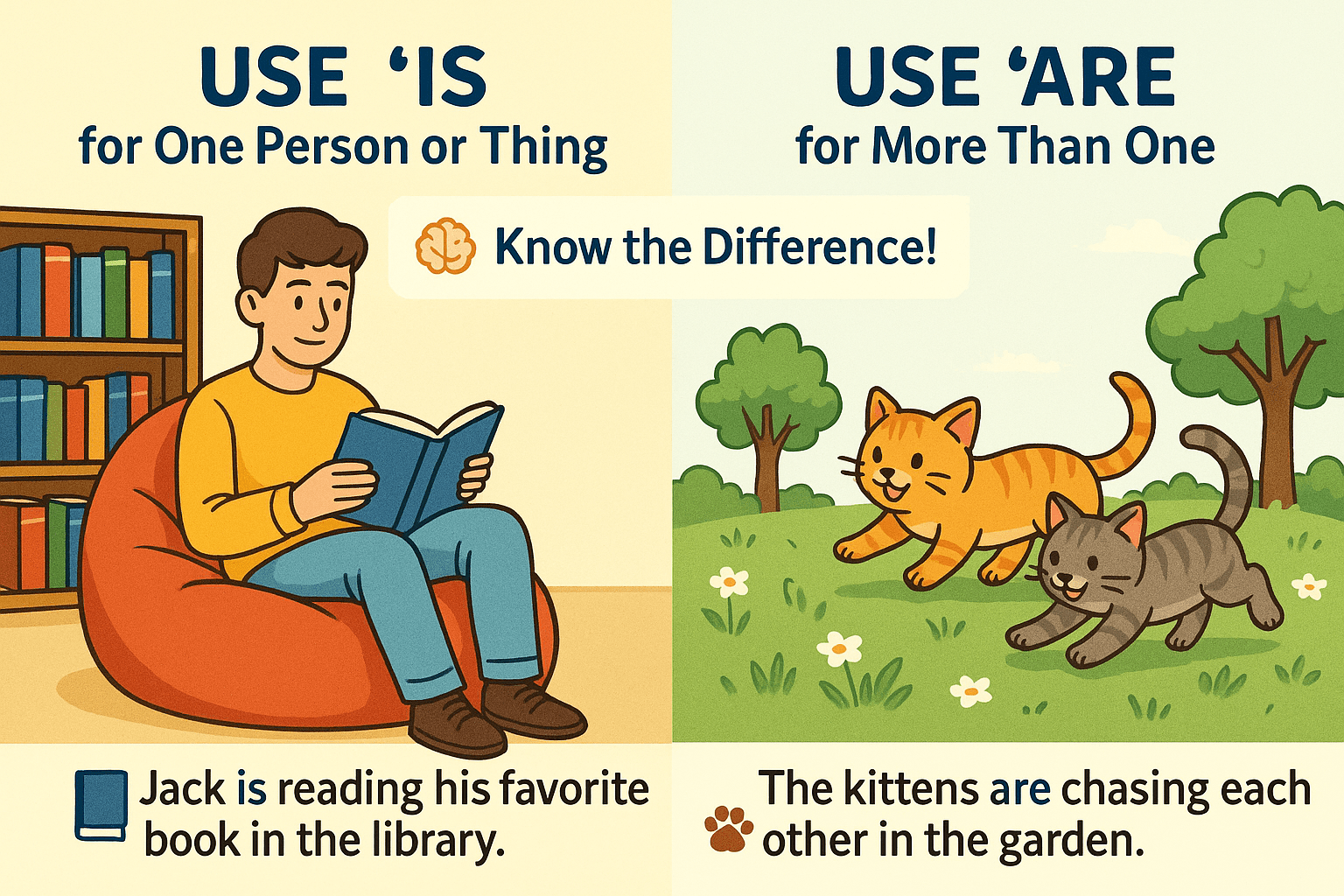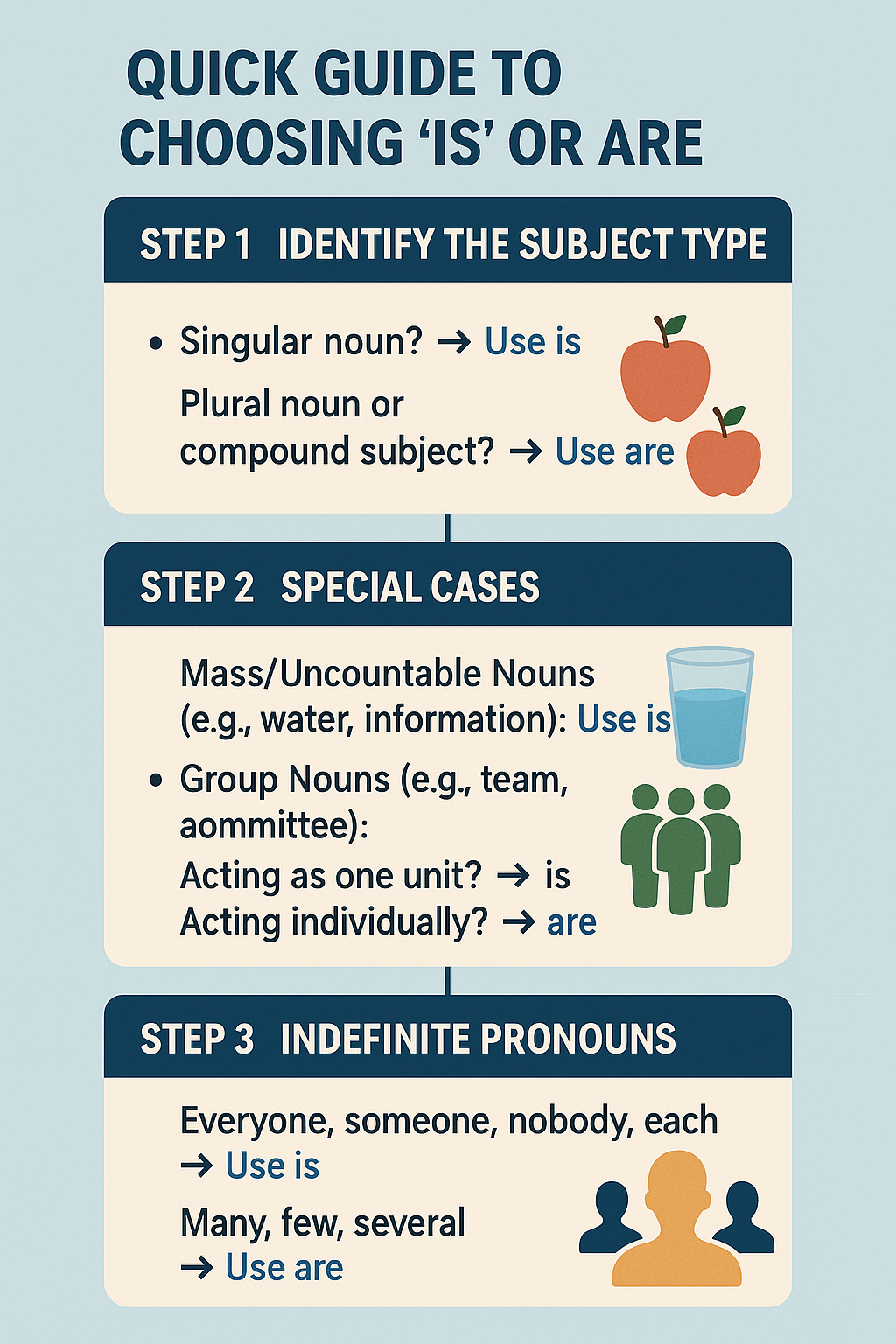Is vs Are: How to Use Them Correctly in Sentences
Table of contents
- 1 Subject-Verb Agreement: The Foundation
- 2 When to Use Are Vs Is in English
- 3 When to Use “Is”?
- 4 When to Use “Are”?
- 5 When to Use Is or Are Examples?
- 6 Special Cases
- 7 Commonly Confused Cases With Indefinite Pronouns, Plural Subject, and More
- 8 Common Mistakes to Avoid
- 9 Tips to Remember
- 10 📚 Test Yourself: Mini Quiz
- 11 Final Thoughts
⚡ Summary: When to Use Are or Is in English Language:
- Is and are are both forms of the verb to be, used to express existence, condition, identity, or state.
- The correct choice between is vs are depends on the subject: use are with plural subjects and is with singular subjects.
- Group nouns (like team or couple) are usually treated as singular and take is, especially in American English.
- Mass nouns (such as water, sand, or information) are uncountable and pair with is.
- Phrases like “a number of…” require are, while “a team of…” or “a set of…” call for is.
- Although the verb to be is extremely common, its different forms can be puzzling.
- Understanding subject-verb agreement helps you choose between is and are.
Subject-Verb Agreement: The Foundation
Before discussing “is” and “are,” it’s important to understand this agreement in English.
Rules mean the verb (especially in the present tense) must agree in number with its subject:
- Singular subjects take singular verbs.
- Plural subjects take the same verbs.
Example:
- The dog is barking. (singular)
- The dogs are barking. (plural)
When to Use Are Vs Is in English

What Do “Is” and “Are” Mean in the Present Tense?
If you have ever been confused about when to use “is vs. are,” you should know that you are not alone. This is a common enough mistake, considering that the two words have a similar origin. Therefore, knowing which term to use can be tricky, particularly when writing more complex sentences.
Well, your problems with are vs is grammar are about to be solved. The guidelines and examples below will allow you to understand how and rely on each word better. In turn, this will greatly reduce the number of mistakes that you will make in the future.
The actual difference between “is” and “are” is as follows:
- Is: the third-person singular present tense of “to be”.
- Are: the first-person plural present, second-person singular and plural present, and third-person plural present tense of “to be.”
When to Use “Is”?
When the Subject Is Singular
Use is whenever the subject of your sentence is a singular noun or indefinite pronoun.
For example:
- The cat is sleeping on the couch.
- Is she ready for the meeting?
- Where is the missing book?
- Sitting by the fire is his favorite pastime.
- Not only is the baby sleeping, but he is also smiling in his sleep.
When Dealing With Mass Nouns Like Water, Sand, or Information
They are also called uncountable. They mean things that can’t be counted individually.
Since words like water, sand, and information represent a whole substance, they always take is.
Examples:
- Water is essential for life.
- This information is very helpful.
When a Collective Noun Is Treated as a Single Entity
When words like team, band, or class act as one unit, use is.
Examples:
- The team is winning the game.
- The team is planning a trip.
When to Use “Are”?
Is or Are for Plural
For example:
- The students are studying for exams.
- Are they planning a surprise party?
- What are the kids doing outside?
- Running and jumping are the puppies’ favorite activities.
- Not only are the players training hard, but they are also studying the game strategy.
When Dealing With Nouns in Plural
When plural nouns, pronouns, or subjects are joined by “and”, always use are.
Examples:
- The dogs are barking loudly.
- My brother and sister are coming over.
When a Collective Noun Is Treated as Individual Members
Sometimes they are seen as separate individuals, especially in British English.
Example: The jury are arguing among themselves.
There Is vs. There Are
“There is” and “There are” introduce the existence of something.
- Use there is for words in the singular: There is a book on the table.
- Use there are for words in plural: There are many books on the table.
When to Use Is or Are Examples?
| Subject | Sentence Example | Verb |
| Singular noun | The book is on the table. | is |
| Singular indefinite pronoun | Everyone is ready to start. | is |
| Mass noun | The water is cold. | is |
| Collective noun (single entity) | The team is practicing hard. | is |
| Plural noun | The books are on the shelf. | are |
| Compound subjects | My brother and sister are arriving soon. | are |
| Collective noun (separate individuals) | The staff are enjoying their vacations. | are |
| Plural indefinite pronoun | Many are attending the meeting. | are |
Real-Life Examples:
- Is there any milk left in the fridge? (Interrogative)
- Why are the lights on during the day? (Interrogative, pronoun “the lights”)
- Watching movies is one of their favorite weekend activities. (Gerund)
- Neither the manager nor the employees are available right now. (Either/or structure with plural)
- Here are the keys you were looking for. (Inversion)

Special Cases
Handling Phrases Like “A Number of…” (Use Are) vs. “A Collection of…” (Use Is)
Certain phrases can upturn even experienced writers. Here’s a common mistake to watch for:
- A number of students are missing. (Multiple ideas → use are)
- The number of students is growing. (One idea → use is)
- A collection of people is waiting outside. (One unit → use is)
Context-Driven Use of Group Nouns
Depending on context, it can take either is or are:
- If the set acts together as one, use is.
- If the set members act individually, use are.
Examples:
- The committee is making a final decision. (single unit)
- The committee are having lunch at different times. (individuals)
Either/Or and Neither/Nor
When subjects are connected by “either/or” or “neither/nor,” the verb agrees with the subject closer to it.
Examples:
- Either the cat is sleeping or the dogs are barking.
- Neither the manager nor the employees are available.
- Neither the employees nor the manager is available.
Commonly Confused Cases With Indefinite Pronouns, Plural Subject, and More
Even when you know the basics of is or are grammar rules, some sentences can still be tricky. Let’s break down common cases where writers often get confused.
1. Two Subjects Joined by “And” or “Or”.
- Subjects joined by and usually take a plural verb because they refer to multiple people or things.
Instance: The cat and the dog are playing in the yard.
Singing and dancing are part of the festival celebration.
Are the cat and the dog getting along better now?
Why are peanut butter and jelly considered a classic pair?
- When two subjects are seen as one idea or unit, use is:
Instance: Peanut butter and jelly is my favorite sandwich.
- When using or, the verb agrees with the subject that is closer to it:
Either the teacher or the students are attending.
Either the students or the teacher is attending.
2. Indefinite Pronouns.
- Some pronouns like everyone, someone, and each always take a singular form:
Instance: Everyone is excited.
- Others, like many, few, and several, mean multiple people and use a plural verb:
Example: Few are ready.
3. Collective Words and Non-countable Nominals.
- Words that mean collections, such as team, committee, or family can act as either singular or plural, depending on the meaning:
The team is winning. (acting as a single body)
The team are arguing among themselves. (individual actions of members)
- Uncountable nouns like water, information, and furniture always behave as singular:
Instance: The information is useful.
4. Special Phrases.
- “A number of” + noun → use are: A number of students are missing.
- “The number of” + noun → use is: The number of students is increasing.
- Expressions like a pair of, a set of, or a team of are generally singular:
A band of friends is going to the party.
A pair of shoes is on sale.
Common Mistakes to Avoid
Some common pitfalls can trip you up even when you understand when to use is vs are. Let’s review them:
1. Confusing “A Number of” vs. “The Number of”
- Incorrect (and sounds wrong): A number of students is missing.
- Correct: A number of students are missing. (A number of refers to many students, so use are.)
(and it sounds a bit strange, but it is grammatically right):
The number of students is increasing.
(The number is a single quantity, so use is.)
Why does it feel odd?
In “The number of students is increasing,” the subject is not students but the number. Always focus on the true subject.
2. Treating Substances as Singular or Plural
- Incorrect: The information are useful.
- Correct: The information is useful.
Why does it feel odd?
“Information” may describe many pieces, but it’s considered a substance and always takes is.
3. Misreading Group Nouns
- Incorrect: The team are winning the game. (in American English)
- Correct: The team is winning the game. (American English — team treated as one unit)
Why does it feel odd?
In British English, “team” can be treated as plural (are winning), but in American English, team is treated as one unit.
4. Thinking Compound Subjects Are Singular.
- Incorrect: My brother and sister is coming over.
- Correct: My brother and sister are coming over.
Why does it feel odd?
Even if brother and sister feel like a single family unit, two people are involved — such subjects require are.
5. Getting Tripped Up by Indefinite Pronouns.
- Incorrect: Everyone are happy today.
- Correct: Everyone is happy today.
Why does it feel odd?
“Everyone” refers to many people, but grammatically it’s singular! Always pair it with is.
Tips to Remember
If you ever hesitate between “is” and “are,” these quick guidelines will help you master the English language:
Rule of Thumb:
Decide whether you’re talking about one thing or more than one.
- One = is
- More than one = are
Think About Substances:
Items like water, sand, and advice are treated as one whole, even if they seem like they could be many things.
- For instance, Water is essential for life.
Picture the Situation:
When speaking about collections like teams or families, ask yourself if they are acting together as one unit or separately as individuals.
Check the Person (Present Tense):
- We → use are
- You → use are
- He, she, it → use is
Quick Practice: Is vs Are in a Sentence (Present Tense):
- Is the coffee getting cold already?
- Are the neighbors throwing a party tonight?
- Reading long novels is what relaxes me the most.
- Where are your keys hiding?
📚 Test Yourself: Mini Quiz
Put your knowledge of is vs. are to the test! Choose the correct form for each sentence:
- The team of students ___ meeting after school.
a) is
b) are - Either the cat or the dogs ___ responsible for the mess.
a) is
b) are - Information about the new courses ___ available online.
a) is
b) are - My brother and sister ___ visiting from New York.
a) is
b) are - Where ___ the missing keys?
a) is
b) are - Neither the employees nor the manager ___ ready to present.
a) is
b) are - Sitting under the old oak tree ___ her favorite thing to do in summer.
a) is
b) are

📝 Answer Key:
- a) is
- b) are
- a) is
- b) are
- b) are
- a) is
- a) is
Final Thoughts
Now that you understand how to use is and are, you’re less likely to make common mistakes when writing important emails or documents.
If you are still unsure, consider working with an essay writing service like PapersOwl. Professional guidance can help you polish your grammar skills and build lasting confidence. If you need comprehensive writing support, hiring them to write my essay is a simple solution.
Remember, if you’re struggling with English writing — whether academic, professional, or personal — getting expert help is one of the best ways to improve. With the right support, you can master the right forms and significantly enhance your writing abilities. Don’t hesitate to take advantage of this opportunity!
Use “is” when speaking about one person, place, thing, or idea, and “are” when referring to more than one. Understanding this basic rule helps you form grammatically correct sentences.







